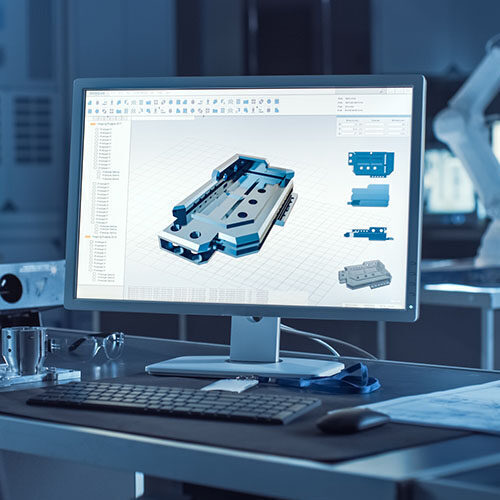
Implementing a new ERP system is one of the biggest, and most challenging projects your organization will ever take on. An ERP touches every aspect of your operation, and will most likely change how every single one of your employees does there job, making it is a massive undertaking, to say the least, to get a new ERP up and running in your manufacturing shop.
If you have failed to successfully implement an ERP in the past—don’t worry you’re not alone, up to 75% of ERP implementation projects are considered failures. But don’t give up, below we outline our top 5 tips to successfully complete an ERP implementation project. We want you to succeed and reap the many benefits an ERP can offer you: be part of the 25% of businesses who can enthusiastically claim that their ERP implementation was a success!
1. Get everyone on board before you start
This is something that our CEO Jean Magny feels very passionate about. With decades of experience in the manufacturing industry helping to guide manufacturers through successful implementation processes, Jean has found that the number one thing that derails an ERP project is not poor planning or a lack of time, it’s not having a vision—and not communicating that vision to your entire company.
Your ERP project is going to be disruptive—it’s going to affect every department in your organization, and it’s going to change how your staff does their jobs. To see a project of this magnitude through to completion, and to get through the hard times, you need to have a strong vision for what your new ERP is going to do for your company. And you need to effectively communicate this vision to everyone in your organization: make sure that everyone in your organization is on the same page about why you are going through such a disruptive process—and what the ultimate endgame will be.
Even though you will have key people responsible for the implementation, your entire organization is going to have to dig deep—and accept changes—to get the project completed. Get everyone from upper management—they need to be clear on the budget and the resources that are needed for such a project—to end users who will be interacting with the system on a day-to-day basis on board before you start your project.
You decided you needed a new ERP system to make your manufacturing shop a more efficient and better business. Make sure everyone throughout your organization knows it.
2. Pick an awesome project sponsor
This speaks to the above point, but you need an awesome project sponsor to get a project as large as an ERP implementation successfully completed. Pick someone who passionately believes in the project and the outcomes an ERP will bring to organization, someone who is a great leader, as well as someone people feel able to approach openly and feel they can bring issues to, big or small, without any judgement.
These are a special set of qualities that your sponsor needs to possess, so choose wisely amongst your team. Who you pick as your project sponsor will have a great deal of influence over the success of your implementation project, so finding someone who is a great planner, able to be flexible, and an excellent communicator is key.
It’s no good having someone who is passionate about the project, but staff members are intimidated to approach with problems. Successfully implementing an ERP requires strong and open lines of communication. It’s easier to resolve a problem early on in the implementation stage, than when it has become a major operational issue down the line.
3. Gather your A-team
A great leader is nothing without the right team to lead. To successfully implement an ERP system you need a team of key people on your staff to support your project sponsor and to help implement the ERP in each department of your organization. Pick a team that comes from across your organization—focusing on departments that will be key to the operation and success of your ERP system.
An important tip: don’t stack your implementation team with upper management only, but have people that do the actual work, day-in, day-out. You are going to have to align all of your organization’s business processes with your new ERP system, so picking people who know those processes inside and out will help you to better map them to your new system, and help you successfully complete the project.
And just as with picking your project sponsor, pick staff members who are open to change—you won’t get very far if the people responsible for implementation are resistant to doing things a new way and don’t want to change how things have always been done.
4. Plan, plan, and then plan some more
Plan a realistic timeline for your project, and preferably one that happens in stages. Getting a new ERP, with its complete set of functionalities and features up and running at once is, I’m just going to say it, impossible. An ERP is just too big, touches on too many aspects of your manufacturing operation to get it all going in one shot. Today’s ERP’s, even with improved user interfaces and user-friendly features, are large and complicated systems.
It may seem backwards, but to get your entire ERP up and running performing at its maximum capacity it’s best to implement your ERP in stages. If you try to do everything at once you will have a much greater chance of failure, fatigue and burnout. But if you break it off into easily digestible chunks, you are much more likely to get your project completed. Not only does implementing your ERP project this way make the task more realistic and simpler for your organization to handle, it also means you can continuously build on your successes—with each successfully implemented component your team will feel more confident and more sure that the disruption to their workplace is worth it.
But to do this you have to do a lot of planning ahead of time. You have to really know your organization, parse through your business processes, and identify what needs to be done first, and what can wait. Once you have done a deep-dive into your organization and your processes, you will be able to create a realistic, and easy to follow plan for your ERP rollout. It might take a little longer than you expected, but you will get more functionality out of your system in the long run, that it will definitely be worth it.
5. Train, train, and then train some more
One of the biggest mistakes manufacturers make when implementing an ERP system is not putting enough time or effort into properly training their staff. If this is your first ERP system, or even if you have had one before, migrating to a system that is completely different from what your staff has been using before is no easy task. You need to devote a lot of time and resources towards training to make sure that your staff knows how to properly use the system, and how to do all parts of their job on the new system.
Be patient, and allow time for learning—it will take time to get everyone comfortable and up to speed. Give your staff time to learn, and make mistakes—it’s better if they make them during the training phase, and not when your system is live. I know you are anxious to start seeing your ERP in action, but taking the proper time and energy to completely train your staff, and letting them feel confident with the new system, will pay off in the long run.
Implementing an ERP is hard—after all most really good things don’t come without a lot of hard work. If you want to successfully implement an ERP system, put a lot of planning and resources into the project up front. Taking the time to get your entire organization on board, and building a solid team, and putting a realistic plan in place will help you reap the rewards of a successful implementation project. A little, or more accurately, a lot of hard work up front, will ensure you have a better more efficient business for the long run.
And a bonus tip: Be kind to yourself and your team. Even with the best planning, a great team in place, and a well considered timeline, mistakes and problems are always going to pop up on a project of this scale. Remind yourself that what you and your team are trying to accomplish is huge—and not an easy undertaking. Take a few deep breaths, let the moment pass, and then forge on. You can be confident that all the hard work ad energy you and your team have put into this project will help you get through the hard parts.
Get your eBook Scared to implement a new ERP?
"*" indicates required fields



